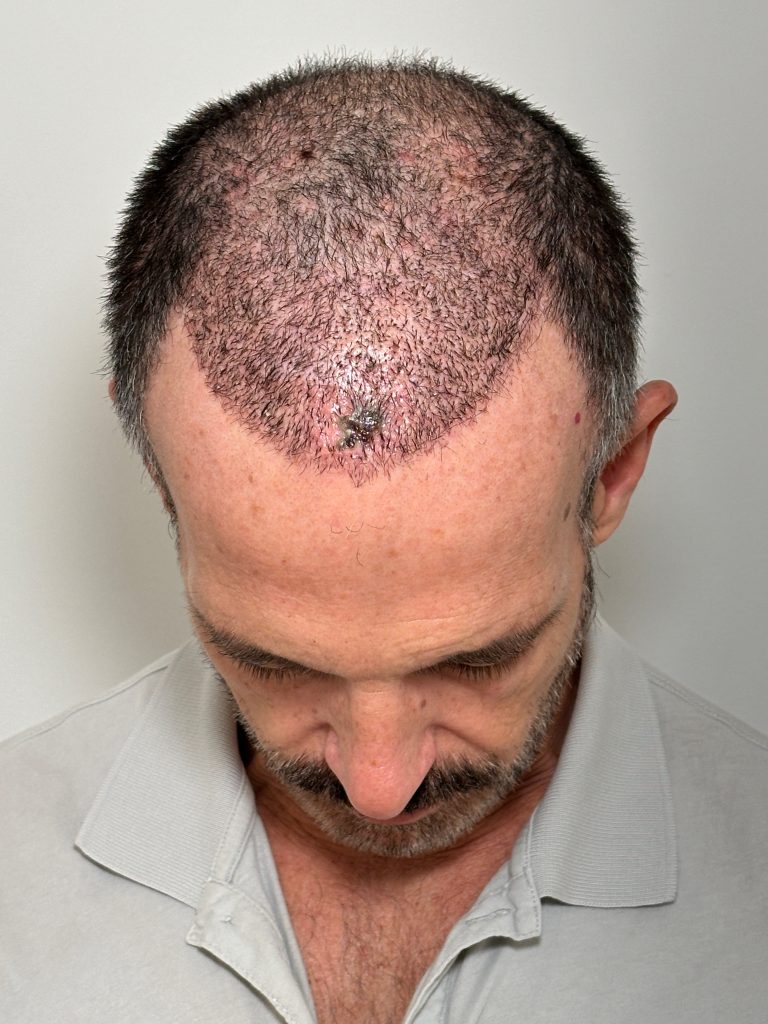Hair transplants have become a popular solution for those looking to restore their hairline and confidence. However, the allure of low-cost procedures offered by black-market clinics can lead to devastating results. Dr. Maxim Chumak, a full-time hair transplant physician, recently shared a harrowing case of a patient who suffered severe complications after undergoing a hair transplant at an illicit clinic. This blog post will explore the details of the case, the treatment provided, and the critical importance of choosing a reputable clinic.
The Case: A Hair Transplant Gone Wrong
Dr. Maxim Chumak encountered a 55-year-old male patient who had traveled to Turkey, a well-known destination for hair restoration tourism, to undergo a hair transplant. Upon his return to the United States, the patient sought immediate medical attention just three days after his procedure. He presented with a concerning blackened area in the middle of his scalp, accompanied by redness in the surrounding area. This alarming discoloration and inflammation signaled a severe complication: necrosis of the recipient area.

Understanding Necrosis and Its Causes
Necrosis, or the death of tissue, can occur in hair transplant procedures due to several factors. In this case, Dr. Chumak identified that the necrosis resulted from vascular damage. This damage likely occurred because the implantation sites were created too close together or too deep, disrupting the vascular network that supplies oxygen to the scalp. Without adequate blood flow and oxygen, the tissue can suffer from ischemia—a condition where the blood supply is restricted or reduced—leading to tissue death or necrosis.
The Consequences of Inadequate Surgical Practices
Further investigation revealed that the patient had chosen a clinic where the hair transplant procedure was performed entirely by technicians, without the direct involvement of a qualified doctor. This lack of professional oversight and expertise significantly increases the risk of complications, as was the case here. The compromised blood flow not only led to necrosis but also created a breeding ground for infection. The patient’s scalp showed significant redness, indicating an active infectious process, which further complicated his recovery.
The Clinic’s Response: A Lack of Accountability
Adding to the patient’s distress, the clinic in Turkey ceased communication with him after he reported his complications. Despite sending pictures of his condition, the clinic did not offer any support or follow-up care, leaving the patient to deal with the consequences alone. This lack of accountability is a common issue with many black market clinics, which often prioritize profit over patient safety and quality care.
The Treatment Plan: Mitigating Damage and Promoting Healing
Upon seeing the patient, Dr. Chumak’s immediate focus was on minimizing the damage and promoting the survival of the implanted grafts. He initiated hyperbaric oxygen therapy (HBOT), a treatment designed to hyper-saturate ischemic tissue with high levels of oxygen. Over the course of more than 20 HBOT sessions, this therapy helped reduce the area of necrosis and promote healing in the affected zone. You can see the affect of HBOT in healing the dead tissue in the photos below.


However, despite these efforts, some small areas of the scalp did not retain the implanted grafts, meaning the patient will likely need another transplant to address the lost grafts. You can see the poor growth of hair grafts in the photos below.


Conclusion: The Importance of Choosing a Reputable Clinic
Dr. Chumak’s case study serves as a stark reminder of the risks associated with black-market hair transplant clinics. The complications experienced by this patient could have been avoided with proper surgical techniques and professional oversight. Before deciding on a hair transplant, it is crucial to thoroughly research the reputation of both the doctor and the clinic. Ensuring that safety and quality are prioritized over cost can prevent severe complications like necrosis and infection, ensuring a successful and safe hair restoration journey.